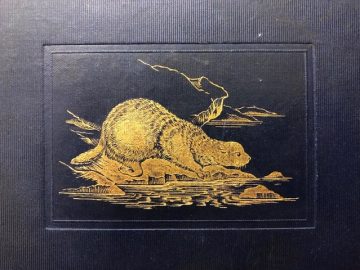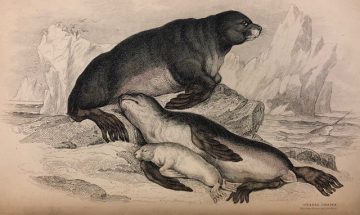Many thanks to guest blogger Alvionne Gardner-Harrison for contributing the below post! Alvionne is a graduate student at UBC’s iSchool (School of Library, Archival and Information Studies) and is currently working with UBC Library’s W.C. Gibson History of Science and Medicine Collection as a professional experience project.
An Ocean of Knowledge, a Sea of Books: The Ocean and its Inhabitants in the W.C. Gibson History of Science and Medicine Collection
For Science Literacy Week 2019, one of the exhibits shared by Rare Books and Special Collections focused on materials from the W.C. Gibson History of Science and Medicine collection. With exhibit items ranging from sea otters on book-bindings to hand-painted seaweed fronds, and from the earliest studies in microscopy to guides for hobbyist naturalists, “An Ocean of Knowledge, a Sea of Books” gives some historical background to the ocean science highlighted in this year’s Science Literacy Week theme.
The exhibit of European scientific literature and illustration from the 17th-19th century explores representations of oceanic life and the techniques and technologies that were used to gather, organize, and distribute information about oceanic organisms. For much of the history of science that the W.C. Gibson collection documents, manuscripts and printed books were the main format in which new scientific observations and ideas were disseminated. The physical qualities of organisms such as fish, molluscs, and sea mammals that were encountered on colonial scientific expeditions, could best be preserved through detailed illustrations that were then reproduced in copperplate and sometimes coloured by hand. These striking images, organized according to new taxonomic systems like that of Linnaeus, were distributed in books such as those in this exhibit. The books included in the exhibit’s cases, some of which are featured below, highlight both ocean science and scientific literacy prior to the 20th century.
Microscopy, Taxonomy, and Colonial Voyages
Significant advances in technology, both intellectual and material, were required for European scientists to systematically study oceanic organisms, as was the expansion of colonial voyages. Antonie van Leeuwenhoek and Robert Hooke contributed to the nascent biological sciences through their development of microscopes and their demonstration of how they could be used to study microscopic organisms and the structures within larger organisms.
- Hooke, Robert. Micrographia (1665). [QH271 .H79 1665]
- Leeuwenhoek, Antoni van. Vervolg der brieven (1704). [QH41 .L4393]
- Mantell, Gideon Algernon. Thoughts on animalcules: or, A glimpse of the invisible world revealed by the microscope (1846). [QL365 .M35 1846]

Snow, In forbidden seas. [F5817.S3 S6].
- Pennant, Thomas. Arctic Zoology, II (1784). [QL105 .P4]
- Linné, Carl von. Systema naturae per regna tria naturae, secundum classes, ordines (1767). [QH43 .S9 1767]
The Material Science Book
The physical descriptions of organisms that were encountered on both local and colonial scientific expeditions could be communicated most effectively through detailed illustrations. These images were then reproduced as prints which were made from copperplate engravings, and which could be easily shared throughout the scientific community. In the 19th century, these illustrations were also widely printed in less expensive—but often beautifully bound—books for the general public, who enthusiastically engaged in early popular science.
- Gosse, Philip Henry. A history of the British sea-anemones and corals: with coloured figures of the species and principal varieties (1860). [QL377.C7 G67 1860]
- Adams, Henry Gardiner. Beautiful shells: their nature, structure, and uses familiarly explained, with directions for collection, cleaning, and arranging them in the cabinet and descriptions of the most remarkable species (1871). [QL405 .A33 1871]
- Recent polar voyages: a record of discovery and adventure from the search after Franklin to the British polar expedition, 1875-76 (1877). [G625 .R35]

Hamilton, The natural history of the amphibious carnivora. [QL737.P6 H2 1839]
- Hooker, Joseph Dalton. The botany of the Antarctic voyage of H. M. discovery ships Erebus and Terror, in the years 1839-1843, under the command of Captain Sir James Clark Ross (1844). [QK5 .E6 1844]
Inconceivable Ichthyology
This case featured examples of illustrations depicting fishes identified and illustrated during global voyages of exploration and organized according to the binomial nomenclature of Linnaeus.
- Richardson, John. Ichthyology of the voyage of H.M.S. Erebus & Terror, under the command of Captain Sir James Clark Ross (1844). [QL636 .R52]
- Schomburgk, Robert Hermann. Natural history of the fishes of Guiana (1843). [QL632.A3 B8 1843]
- Bennett, James William. A selection of rare and curious fishes found upon the coast of Ceylon: from drawings made in that island, and coloured from life, with letter-press descriptions (1851). [QL634.C3 B4 1851]
- Fries, Bengt Fredrik. A History of Scandinavian Fishes, Vol. II (1893). [QL633.S22 F74 1893 v.2]
From “Sea Monsters” to Seals
In addition to an extensive selection of books on fishes, the Gibson collection includes scientific materials on aquatic plants, molluscs, seabirds, and sea mammals, among other groups of organisms recognized during the 19th century.
- Sowerby, George Brettingham. Genera of recent and fossil shells (1820). [QL 404 S 68]

Dewhurst, The natural history of the order cetacea. [QL737.C4 D5 1834].
- Dewhurst, Henry William. The natural history of the order cetacea, and the oceanic inhabitants of the Arctic regions (1834). [QL737.C4 D5 1834]
- Hamilton, Robert. The natural history of the amphibious carnivora, including the walrus and seals, also of the herbivorous cetacea. [QL737.P6 H2 1839]
- Snow, Henry James. In forbidden seas: Recollections of sea-otter hunting in the Kurils (1910). [F5817.S3 S6]
Original post: https://rbsc.library.ubc.ca/2019/10/24/an-ocean-of-knowledge-a-sea-of-books/



















